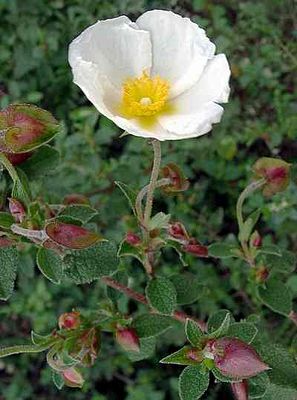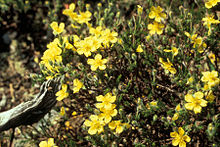Rockrose family
| Rockrose family | ||||||||||||
|---|---|---|---|---|---|---|---|---|---|---|---|---|

Sage-leaved rockrose ( Cistus salviifolius ) |
||||||||||||
| Systematics | ||||||||||||
|
||||||||||||
| Scientific name | ||||||||||||
| Cistaceae | ||||||||||||
| Yuss. |
The plant family of the rockrose plants (Cistaceae) belongs to the order of the mallow-like (Malvales).
Description and ecology

Vegetative characteristics
They are mostly small shrubs or herbaceous plants . Often they have an aromatic smell, some species are xerophytes .
The mostly opposite, sometimes alternate or arranged in whorls , the leaves can be sessile or stalked. The simple leaf blades can be herbaceous or leathery. There are species in which the leaves are partially or completely reduced.
To protect against dehydration, many species are hairy, with very different forms of hairiness, but mostly they are star-shaped. Further protective mechanisms are the rolling in or shedding of the leaves, or the formation of water-storing rhizomes .
Generative characteristics
The flowers are solitary or in zymose inflorescences .
The hermaphroditic flowers are radially symmetrical and usually five-fold with a double flower envelope (perianth). There are five or three sepals ; if there are five sepals, then the outer two are significantly smaller. The short-lived, free, always strikingly colored petals can be very large and often look wrinkled.
Of the mostly numerous (rarely only three, often up to 100) stamens in the rockrose family, the inner ones ripen first (centrifugally), which is relatively unusual. In many species, the anthers cover the stigma, and when touched they curve outwards (sensitive stamens) so that the stigma is released. Carpels are three or five to ten per flower, they are fused to form an upper ovary. There is a stylus and a scar.
There are fruit capsules formed by protein-containing seeds.



Locations
The species of the Cistaceae mostly prefer dry, sunny locations and they form an important part of the garrigue vegetation of the Mediterranean region.
Systematics and distribution
The Cistaceae family was established in 1789 by Antoine Laurent de Jussieu in Genera Plantarum , p. 294. A synonym for Cistaceae Juss. nom. cons. is Helianthemaceae G.Meyer .
Taxonomic treatments of taxa of the Cistaceae family are available, for example, from Tournefort 1718, Linné 1753, Dunal 1824, Spach 1836, Willkomm 1856, Grosser 1903, Ponzo 1921, Martín Bolaños and Guinea 1949, Arrington and Kubitzki 2003. Important scientific work was carried out on the basis of molecular genetic data by Guzmán and Vargas 2005, Guzmán and Vargas 2008 and Guzmán and Vargas 2009.
The Cistaceae family belongs to the Malvales order .
The areas of most taxa are in the temperate latitudes of the northern hemisphere . Most of the species in the family are found in the Mediterranean . Only a few genera are found in eastern North America or isolated in small areas of South America ( Crocanthemum , Hudsonia ).
The family Cistaceae contains about eight genera with about 180 species (as of 2009):
- Rockrose ( Cistus L. ): The 18 or so species thrive in the temperate latitudes of the northern hemisphere .
- Crocanthemum Spach : The approximately 24 species are common in the New World.
-
Coniferous herb ( Fumana (Dunal) Spach ): The nine or so species are common in Europe and North Africa, including:
- Common needle rose ( Fumana procumbens (Dun.) Gren. & Godr. )
- Upright coniferous herb ( Fumana ericoides (Cav.) Gand. )
- Thyme-leaved coniferous herb ( Fumana thymifolia (L.) Spach )
- Halimium (Dunal) Spach : The approximately nine species are distributed in the Mediterranean area .
- × Halimiocistus Janchen (= Cistus × Halimium )
- Sun rose ( Helianthemum Mill. , Syn .: Atlanthemum Raynaud ): The 80 to 100 species are widespread from Europe and North Africa to Central Asia (e.g. also in German-speaking countries).
-
Hudsonia L .: There is only one type:
- Hudsonia ericoides L .: It is common in North America.
- Lechea L .: The approximately 17 species are common in the New World.
-
Sandröschen ( Tuberaria (Dunal) Spach , Syn .: Xolantha Raf. , Therocistus Holub ): The approximately twelve species are distributed in the Mediterranean area, in Western and Central Europe, including:
- Spotted sandherb ( Tuberaria guttata (L.) Fourr. )
- Tuberaria lignosa (Sweet) Samp.
- According to APG IV, the genus Pakaraimaea also belongs to the family Cistaceae; with the only kind:
- Pakaraimaea dipterocarpacea Maguire & PSAshton , a neotropical tree with ectomycorrhiza from the western highlands of Guyana and adjacent areas in the Venezuelan state of Bolivar.
swell
- The family of Cistaceae in APWebsite . (Section systematics)
- Saiyad Masudal Hasan Jafri: Flora of West Pakistan 112: Cistaceae. Stewart Herbarium, Gordon College (et al.), Rawalpindi 1977: Cistaceae at Tropicos.org. In: Flora of Pakistan . Missouri Botanical Garden, St. Louis (Description Section)
Individual evidence
- ↑ a b c d e f g h i j k l B. Guzmán, P. Vargas: Historical biogeography and character evolution of Cistaceae (Malvales) based on analysis of plastid rbcL and trnL-trnF sequences. In: Organisms Diversity & Evolution , Volume 9, Issue 2, 2009, pp. 83-99. doi : 10.1016 / j.ode.2009.01.001
- ↑ Cistaceae at Tropicos.org. Missouri Botanical Garden, St. Louis, Retrieved June 21, 2017.
- ↑ JP Tournefort: A Voyage into the Levant , Volume ID Browne et al., London, 1718.
- ^ Carl von Linné: Species Plantarum , L. Salvius, Stockholm, 1753.
- ↑ MF Dunal: Cistineae. In: AP De Candolle (Ed.): Prodromus Systematis Naturalis Regni Vegetabilis I, Treuttel et Wurtz , Paris 1824, pp. 263-286.
- ^ E. Spach: Conspectus monographiae Cistacearum. In: Annales des sciences naturelles. Botanique. , Volume 6, 1836, pp. 357-375.
- ↑ M. Willkomm: Cistinearum Orbis Veteris Descriptio Monographica. Icones et Descriptiones Plantarum. AH Payne, Leipzig, 1856.
- ^ W. Grosser: Cistaceae. In: A. Engler (Ed.): Das Pflanzenreich , Breitkopf & Härtel, Berlin 1903, p. 161.
- ^ A. Ponzo: Considerazioni sulle Cistaceae. In: N. Giorn. Bot. Ital. , 28, 1921, pp. 157-173.
- ↑ M. Martín Bolaños, E. Guinea: Jarales y Jaras (Cistografia Hispanica). Inst. Forestal Invest. Exper., Direcc. Gene. Montes, Caza Pesca Fluvial, Ministerio de Agricultura, Madrid, 1949.
- ^ JM Arrington, Klaus Kubitzki : Cistaceae. In: Klaus Kubitzki (Ed.): The Families and Genera of Vascular Plants , Volume IV: Flowering Plants. Dicotyledons. Malvales, Capparales and Non-betalain Caryophyllales , Springer, Berlin, 2003, pp. 62-70.
- ^ A b Angiosperm Phylogeny Group: An update of the Angiosperm Phylogeny Group classification for the orders and families of flowering plants: APG IV. In: Botanical Journal of the Linnean Society , Volume 181, Issue 1, 2016, pp. 1-20. doi : 10.1111 / boj.12385
- ↑ Cistaceae in the Germplasm Resources Information Network (GRIN), USDA , ARS , National Genetic Resources Program. National Germplasm Resources Laboratory, Beltsville, Maryland. Retrieved June 21, 2017.
- ^ A b David John Mabberley: Mabberley's Plant-Book. A portable dictionary of plants, their classification and uses. 3. Edition. Cambridge University Press, Cambridge u. a. 2008, ISBN 978-0-521-82071-4 ( limited preview in Google Book Search).
Web links
- Cistaceae at Tropicos.org. In: IPCN Chromosome Reports . Missouri Botanical Garden, St. Louis
- Cistaceae at Tropicos.org. In: Flora Mesoamericana . Missouri Botanical Garden, St. Louis


